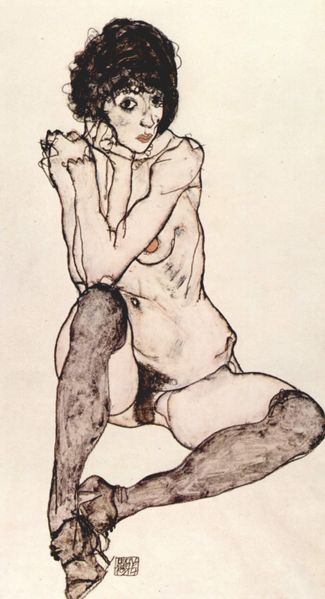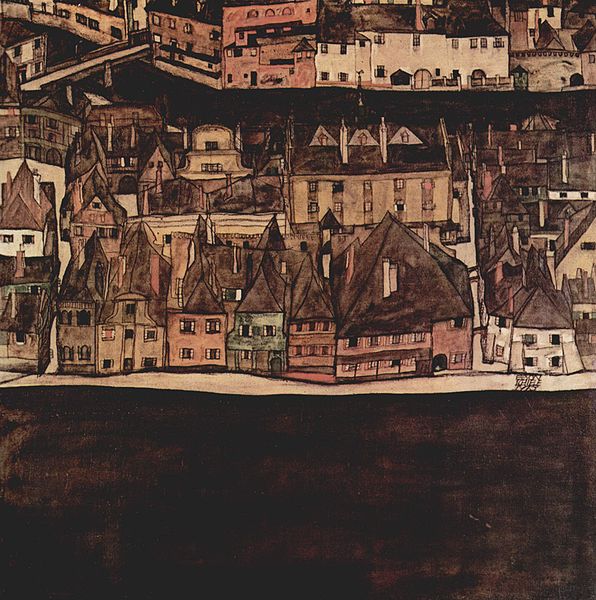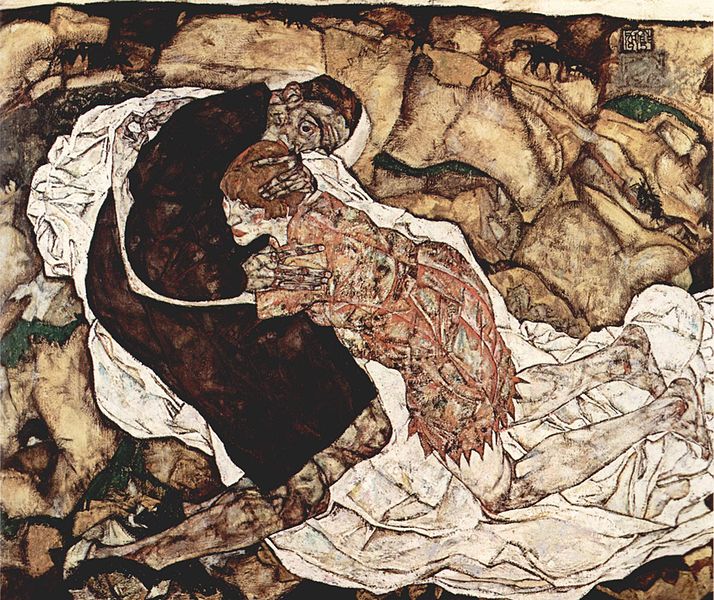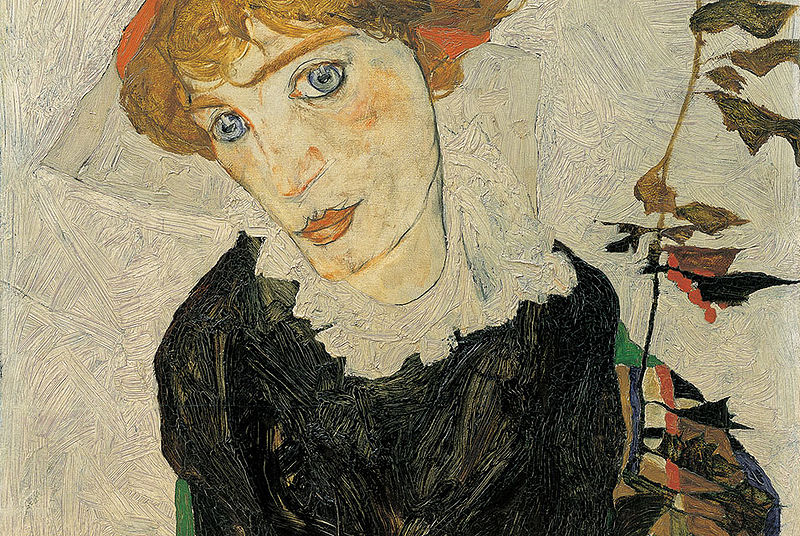<Back to Index>
- Engineer Johann August Röbling, 1806
- Painter Egon Schiele, 1890
- 41st President of the United States George Herbert Walker Bush, 1924
PAGE SPONSOR
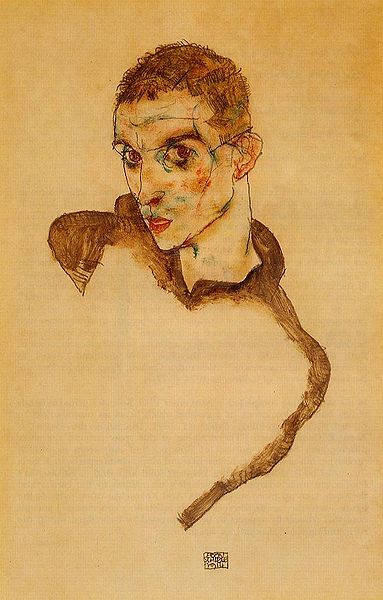
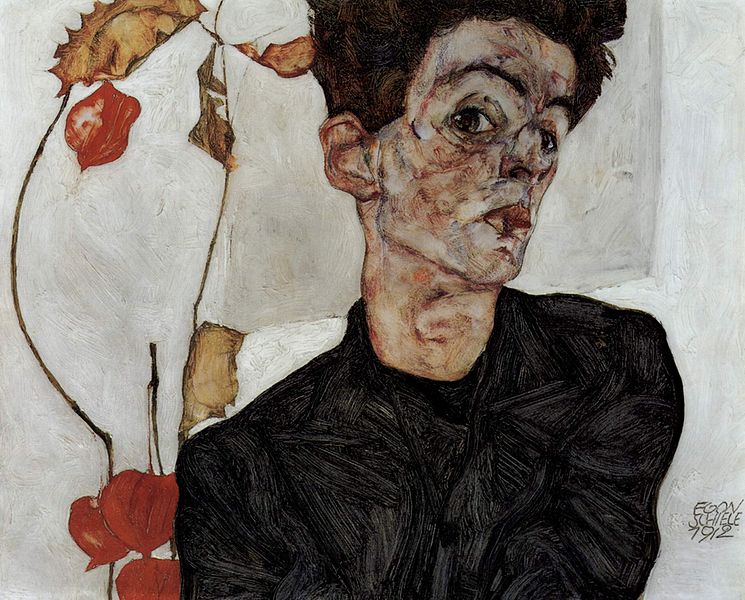
Egon Schiele (June 12, 1890 – October 31, 1918) was an Austrian painter. A protégé of Gustav Klimt, Schiele was a major figurative painter of the early 20th century.
Schiele's work is noted for its intensity, and the many self-portraits the artist produced. The twisted body shapes and the expressive line that characterize Schiele's paintings and drawings mark the artist as an early exponent of Expressionism, although still strongly associated with the art nouveau movement (Jugendstil). The Leopold Museum, Vienna houses perhaps Schiele's most important and complete collection of work, featuring over 200 exhibits. Other notable collections of Schiele's art include the Egon Schiele Museum, Tulln and Österreichische Galerie Belvedere, Vienna.
Schiele was born in Tulln on the Danube. His father, Adolph Schiele, worked for the Austrian State Railways as a station master; his mother, Marie Soukup(ová), was from Krumau, in Bohemia. As a child, he attended the school run by the Stift Klosterneuburg, where his arts teacher K.L. Strauch recognized and supported Schiele's artistic talent.
When Schiele was 15 years old, his father died from syphilis, and he became a ward of his maternal uncle, Leopold Czihaczec, who became distressed by Schiele's lack of interest in academic studies, yet recognized his passion and talent for art. In 1906 Schiele applied at the Kunstgewerbeschule (School of Arts and Crafts) in Vienna, where Gustav Klimt had once studied. Within his first year there, Schiele was sent, at the insistence of several faculty members, to the more traditional Akademie der Bildenden Künste in Vienna in 1906. There, he studied painting and drawing, but was frustrated by the school’s conservatism.
In
1907, Schiele sought out Gustav Klimt. Klimt generously mentored
younger artists, and he took a particular interest in the gifted young
Schiele, buying his drawings, offering to exchange them for some of his
own, arranging models for him and introducing him to potential patrons.
He also introduced Schiele to the Wiener Werkstätte, the arts and crafts workshop connected with the Secession.
In 1908 Schiele had his first exhibition, in Klosterneuburg. Schiele left the Academy in 1909, after completing his third year, and founded the Neukunstgruppe ("New Art Group") with other dissatisfied students.
Klimt invited Schiele to exhibit some of his work at the 1909 Vienna Kunstschau, where he encountered the work of Edvard Munch, Jan Toorop, and Vincent van Gogh among
others. Once free of the constraints of the Academy's conventions,
Schiele began to explore not only the human form, but also human
sexuality. At the time, many found the explicitness of his works
disturbing. Some view Schiele's work as being grotesque, erotic, pornographic, or
disturbing, focusing on sex, death, and discovery. He focused on
portraits of others as well as himself. In his later years, while he
still worked often with nudes, they were done in a more realist
fashion. He also painted tributes to Van Gogh's Sunflowers as well as landscapes and still lifes. In
1911, Schiele met the seventeen year old Valerie (Wally) Neuzil, who
lived with him in Vienna and served as model for some of his most
striking paintings. Very little is known of her, except that she had
previously modelled for Gustav Klimt and might have been one of his
mistresses. Schiele and Wally wanted to escape what they perceived as
the claustrophobic Viennese milieu, and went to the small town of Český Krumlov (Krumau) in southern Bohemia.
Krumau was the birthplace of Schiele's mother; today it is the site of
a museum dedicated to Schiele. Despite Schiele's family connections in
Krumau, he and his lover were driven out of the town by the residents,
who strongly disapproved of their lifestyle, including his alleged
employment of the town's teenage girls as models. Together they moved to Neulengbach,
35 km west of Vienna, seeking inspirational surroundings and an
inexpensive studio in which to work. As it was in the capital,
Schiele's studio became a gathering place for Neulengbach's delinquent
children. Schiele's way of life aroused much animosity among the town's
inhabitants, and in April 1912 he was arrested for seducing a young
girl below the age of consent. When they came to his studio to place him under arrest, the police seized more than a hundred drawings which they considered pornographic.
Schiele was imprisoned while awaiting his trial. When his case was
brought before a judge, the charges of seduction and abduction were
dropped, but the artist was found guilty of exhibiting erotic drawings
in a place accessible to children. In court, the judge burned one of
the offending drawings over a candle flame. The twenty-one days he had
already spent in custody were taken into account, and he was sentenced
to only three days' imprisonment. While in prison, Schiele created a
series of 12 paintings depicting the difficulties and discomfort of
being locked in a jail cell.
In
1914, Schiele glimpsed the sisters Edith and Adéle Harms, who
lived with their parents across the street from his studio in the
Viennese suburb of Hietzing, 101 Hietzinger Hauptstrasse. They were a
middle class family and Protestant by
faith; their father was a master locksmith. In 1915, Schiele chose to
marry the more socially acceptable Edith, but had apparently expected
to maintain a relationship with Wally. However, when he explained the
situation to Wally, she left him immediately and never saw him again.
This abandonment led him to paint Death and the Maiden,
where Wally's portrait is based on a previous pairing, but Schiele's is
newly struck. (In February 1915, Schiele wrote a note to his friend Arthur Roessler stating:
"I intend to get married, advantageously. Not to Wally.") Despite some
opposition from the Harms family, Schiele and Edith were married on 17
June 1915, the anniversary of the wedding of Schiele's parents.
World War I now
began to shape Schiele's life and work. Three days after his wedding,
Schiele was ordered to report for active service in the army where he
was initially stationed in Prague.
In the army, Schiele was treated well by officers who respected his
artistic talent. He never saw any fighting at the front, and was able
to continue painting and sketching while guarding Russian prisoners of
war, and doing light guard duties. By 1917, he was back in Vienna, able
to focus on his artistic career. His output was prolific, and his work
reflected the maturity of an artist in full command of his talents. He
was invited to participate in the Secession's 49th exhibition, held in
Vienna in 1918. Schiele had fifty works accepted for this exhibition,
and they were displayed in the main hall. He also designed a poster for
the exhibition, which was reminiscent of the Last Supper,
with a portrait of himself in the place of Christ. The show was a
triumphant success, and as a result, prices for Schiele's drawings
increased and he received many portrait commissions. During the same year, he also had successful shows in Zürich, Prague, and Dresden. Schiele participated in numerous group exhibitions, including those of the Neukunstgruppe in Prague in 1910 and Budapest in 1912; the Sonderbund, Cologne, in 1912; and several Secessionist shows in Munich, beginning in 1911. In 1913, the Galerie Hans Goltz, Munich, mounted Schiele's first solo show. A solo exhibition of his work took place in Paris in 1914. In the autumn of 1918, the Spanish flu epidemic
that claimed more than 20,000,000 lives in Europe reached Vienna.
Edith, who was six months pregnant, succumbed to the disease on 28
October. Schiele died only three days after his wife. He was 28 years
old. During the three days between their deaths, Schiele drew a few
sketches of Edith; these were his last works. Schiele has been the subject of a biographical film, Excess & Punishment (aka Egon Schiele Exzess und Bestrafung),
a 1980 film originating in Germany with a European cast that explores
Schiele's artistic demons leading up to his early death. The film is
directed by Herbert Vesely and stars Mathieu Carriere as Egon Schiele with Jane Birkin as his early artistic muse and Christine Kaufman as his wife and Kristina Van Eyck as
her sister. As well, his life was represented in a theatrical dance
production by Stephan Mazurek called "Egon Schiele", presented in May
1995, for which Rachel's, an American post-rock group, composed a score titled Music for Egon Schiele. Schiele's life and work have also been the subject of essays, including a discussion of his works by Richard Avedon in an essay on portraiture entitled "Borrowed Dogs." Mario Vargas Llosa uses the work of Schiele as a conduit to seduce and morally exploit a main character in his 1997 novel The Notebooks of Don Rigoberto.
Portrait of Wally, a 1912 portrait, was purchased by Rudolf Leopold in 1954 and became part of the collection of the Leopold Museum when it was established by the Austrian government, purchasing more than
5,000 pieces that Leopold had owned. After a 1997 - 1998 exhibit of
Schiele's work at the Museum of Modern Art in New York City, the painting was seized by order of the New York County District Attorney and had been tied up in litigation by heirs of its former owner who claim that the painting was Nazi plunder and should be returned to them. The dispute was settled on July 20, 2010 and the picture subsequently purchased by the Leopold Museum for 19 Million USD.
